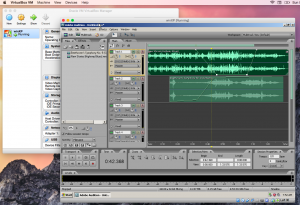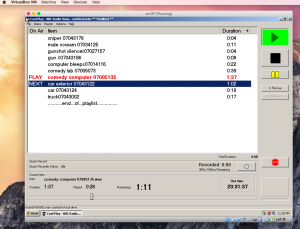I wrote previously about getting CoolPlay to run on a Mac. CoolPlay is WindowsXP software used for playing audio clips, developed for BBC Radio, but it has other uses too, and I don’t know of any Mac software that does the same thing: to allow you to organise a playlist of audio tracks that play one at a time, stopping at the end of each track and waiting for a button to be pressed before playing the next track.
My favourite audio editing / mixing tool is probably Adobe Audition 3 – an old version from 2007, and it was never ported to Mac OS X. More recent versions of Audition are available for Mac, but Audition 3 strikes the right balance for me of simplicity and functionality. It also gained some popularity because it was part of Creative Suite 2, which was released in early 2013 with official serial numbers when Adobe shut down the CS2 activation servers. I still can’t figure out if that means you could nab CS2 and Audition 3 for free, or not.
Could I run Audition 3 on a new MacBook Air running Yosemite? I tried WINE, but without any luck. The Audition installer bombs out very early on. I then thought about using BootCamp to dual-boot the MacBook Air into WindowsXP – but no luck there either. Yosemite and the 2015 MacBook Airs do not support any version of Windows older than 8, and I don’t think Audition 3 plays nicely with Windows 8. It may be possible to install WindowsXP on a new MacBook without using BootCamp, but I have no idea how you’d get the relevant drivers to make XP work properly on Apple hardware.
So I thought I’d have a go at using a ‘virtual machine’ – I installed the free Oracle VirtualBox, and – purely as a proof of concept – installed WindowsXP from an OEM disc. (This Windows install will stop working in 30 days, when it demands to be activated.) I had problems getting VirtualBox to install off a Windows CD-ROM, so I made an ISO disk image of it using OS X Disk Utility (pick the ‘CD master’ option, and rename the resulting .CDR file .ISO), and it worked fine installing from that.
I was very doubtful it would work, but my golly the Audition installer ran perfectly, and it seems to be fast enough to play, edit and mix audio. I even put by MacBook Air to sleep, opened it this morning, Audition was still there and resumed playing instantly when I pressed the space bar. I even managed to record audio straight into Audition running in the virtual WindowsXP machine, using the MacBook Air’s internal microphone, with no tweaking or fiddling with settings. Which is just incredible really.
Mounting USB devices in the virtual XP machine is a bit counter-intuitive; if you plug a memory stick into your Mac, you then have to eject it in OS X, but leave it plugged in so you can then mount it in XP. But it works just fine. I can even see how my web pages look in Internet Explorer 8!

And CoolPlay works too, much more reliably than it does in WINE.

Now if only Microsoft would make WindowsXP free, or open source it…


